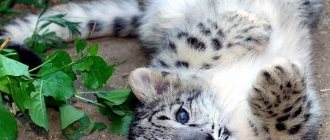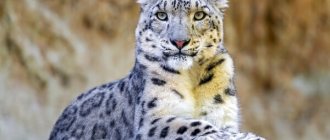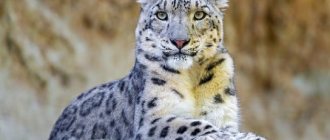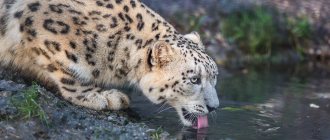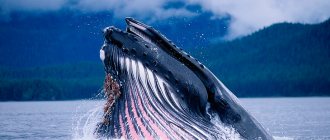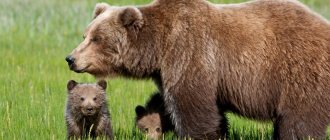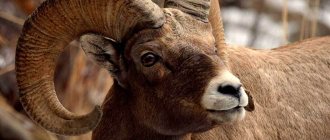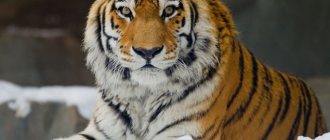- Wild animals
- >>
- Mammals
The snow leopard is an amazing inhabitant of the mountains, a predatory, dexterous, and very graceful animal.
The animal is not called snow for nothing. This is the only representative of the cat family that lives in the mountains, where there is snow all year round. The predator is also called the snow leopard, the lord of the mountains or the snow leopard. In ancient times, due to the similarity of appearance, they were called snow leopards, and were even considered representatives of the same species. However, snow leopards are not related to leopards. They are much stronger and faster, although they are inferior in size. Unfortunately, today this incredibly beautiful predator is on the verge of complete extinction.
Origin of the species and description
Photo: Snow Leopard
Snow leopards are representatives of predatory mammals. They belong to the cat family, separated into the genus and species of snow leopards. The theory of the origin of this amazing and very graceful predator has not yet been formed.
Back at the end of the 16th century, Russian fur traders and artisans heard from Turkic hunters about a mysterious handsome man, whom they called “irbiz”. For the first time, European residents were able to see the strange cat in 1761. Researcher Georges Buffon showed European nobility pictures that depicted a very beautiful wild cat. He supplemented his pictures with information that they are trained and raised to participate in hunting in Persia.
Video: Irbis
Since then, many scientific researchers and zoologists have been interested in this amazing beast. In 1775, the German zoologist-naturalist Johann Schreber wrote an entire scientific work that was devoted to the origin and evolution of animals, as well as a description of their appearance and lifestyle. Subsequently, the Russian scientist Nikolai Przhevalsky also studied the life activity of the snow leopard. A number of scientific, including genetic, examinations were carried out, according to which it was possible to establish that the approximate existence of the feline predator is about one and a half million years.
The first remains of the animal, which by all indications belonged to the snow leopard, were discovered on the western border of Mongolia, in Altai. They are dated to the late Pleistocene period. The next significant find is the remains of an animal in the northern region of Pakistan. Their approximate age is one and a half million years. Initially, snow leopards were classified as panthers. A little later, studies showed that the snow leopard and the panther do not have direct common characteristics.
This representative of the cat family has distinctive features that are not inherent in other representatives of this family. This gives grounds to distinguish them into a separate genus and species. Although today there is no exact information about the origin of the snow leopard genus, scientists are inclined to believe that the snow leopard and the panther did not have common ancestors. The results of genetic testing give reason to believe that they separated into a separate branch a little more than a million years ago.
Snow leopard in Russia
In Russia, the snow leopard is found in the north of its current range. Only a few groups of snow leopards live in the mountains of the Altai-Sayan region. In addition, the predator can be found in Buryatia, Khakassia, Tyva, Transbaikalia, Irkutsk region and Krasnoyarsk region. According to experts, it is in Russia that the northernmost population group of snow leopards lives. The number of this species in Russia is approximately 2% of the total number of snow leopards in the world. It can be said that the survival of predators in Altai largely depends on genetic and spatial connections with animals in Mongolia and China.
Appearance and features
Photo: Animal snow leopard
The snow leopard is an animal of incredible beauty and grace. The body length of one adult individual is 1-1.4 meters. The animals have a very long tail, the length of which is equal to the length of the body. Tail length is 0.8-1 meter. The tail plays a very important role. Animals use it to maintain balance in mountainous areas and to warm their front and hind paws in snow and frost. The weight of one adult individual is 30-50 kilograms.
Sexual dimorphism is not expressed, but males are slightly larger than females. Predators have large front paws with round pads measuring 1*1 cm. Long hind feet ensure fast movement among mountain peaks and deft, graceful jumps. The limbs are not very long, but the paws are thick and powerful. The paws have retractable claws. Thanks to this, there are no traces of claws left in the snow where the graceful predator passed.
The feline predator has a round head, but with small, triangular ears. In winter, in thick, long fur, they are practically invisible. Animals have very expressive, round eyes. The snow leopard has long, thin whiskers. Their length reaches just over ten centimeters.
Interesting fact. The snow leopard has very long and thick fur, which keeps it warm in harsh climates. The length of the coat reaches 50-60 centimeters.
The area of the spinal column and the lateral surface of the body are gray, close to white. The abdominal area, inner surface of the limbs and lower abdomen have a lighter tone. The unique color is provided by ring-shaped dark, almost black rings. Inside these rings are smaller rings. The smallest circles are located in the head area. Gradually, from the head, along the neck and body to the tail, the size increases.
The largest rings are located in the neck and limbs. On the area of the back and tail, the rings merge, forming transverse stripes. The tip of the tail is always black. The color of winter fur is smoky gray with an orange tint. This color allows them to remain unnoticed by steep rocks and snowdrifts. By summer, the coat becomes light, almost white.
Where does the snow leopard live?
Photo: Snow leopard in Russia
Animals live only in mountainous areas. The average altitude of its permanent habitat is 3000 meters above sea level. However, in search of food, they can easily climb to a height twice as high as this figure. In general, the snow leopard's habitat is very diverse. The largest number of animals is concentrated in the countries of Central Asia.
Geographical regions of snow leopard habitat:
- Mongolia;
- Afghanistan;
- Kyrgyzstan;
- Uzbekistan;
- Tajikistan;
- China;
- India;
- Kazakhstan;
- Russia.
In our country, the population of the feline predator is small. They are located mainly in Khakassia, Altai Territory, Tyva, and Krasnoyarsk Territory. The animal lives in mountains such as the Himalayas, Pamirs, Kun-Lun, Sayan Mountains, Hindu Kush, the mountains of Tibet, and many others. Animals also live in protected and protected areas. These include the territory of the Altushinsky and Sayano-Shushensky national parks.
Most often, the predator chooses the territory of steep rock cliffs, deep gorges and bushes as its habitat. Snow leopards prefer regions with low snow cover. In search of food, it can go down to forests, but spends most of its time in mountainous areas. In some regions, snow leopards live at an altitude not exceeding a thousand kilometers above sea level. In regions such as the Turkestan Range, it mainly lives at an altitude of 2.5 thousand meters, and in the Himalayas it climbs to a height of six and a half thousand meters. In winter, they can change their locations depending on the regions where the ungulates live.
The territory of Russia accounts for no more than 2% of the entire habitat of predators. Each adult occupies a special territory, which is prohibited for others.
Where did the bust go?
For Vladimir Chistikov, hiking in the mountains is a way of life. He finds partners on the Internet. A permanent team has formed. By the way, the idea of climbers, borrowed from films, where summit conquerors constantly hang with their backs down on “negative” areas, does not entirely correspond to reality.
Most of these areas can be bypassed, explains Chistikov, although, of course, sometimes you have to storm. For example, at Pobeda Peak there is about five meters on the ice wall. But there are people like Denis Urubko from Kazakhstan. He has conquered all the eight-thousanders on the planet and has now found a new interest - he is going up his own dizzying routes that have never been taken by anyone before. Being high in the mountains is the destiny of few. Mountain peaks are some of the most mysterious points on the planet. And, naturally, they become surrounded by legends.
On Khan Tengri, at an altitude of 6400 meters, there is the last convenient resting place,” says Vladimir Chistikov. – One friend recalled: he put up a tent there for the night, and at night he heard someone walking around. Another one hung up a new rope in advance, got ready to climb up in the morning, and it was untied. They say that the souls of dead climbers play pranks.
And in the Pamirs, according to the hero of the material, there is an abandoned camp. One day a group came there. People immediately felt as if someone invisible was watching them. We approached the shed - the door was wrapped with thick wire with a force clearly superior to human strength. The climbers did not tempt fate, even though their nerves were strong, but they left the camp almost running.
A curious and mysterious story happened at the top of Lenin Peak. During the Soviet years, a bust of the leader of the world proletariat was delivered there. I went up there and there was no bust. And after me there were ascents - the bust is in place,” Vladimir shrugs.
What does a snow leopard eat?
Photo: Snow leopard cat
By nature, the snow leopard is a predator. It feeds exclusively on food of meat origin. It can hunt both birds and large ungulates.
What is the food supply:
- Yaks;
- Rams;
- Roe deer;
- Argali;
- Tapirs;
- Serau;
- Boars;
- Musk deer;
- Marmots;
- Gophers;
- Hares;
- Chukars;
- Feathered;
- Rodents;
- Mountain goats.
For one meal, an animal needs 3-4 kilograms of meat to be completely satisfied.
Interesting fact. The snow leopard eats only at home. After a successful hunt, the leopard carries its prey to its den and only eats it there.
The snow leopard is a unique hunter and can kill several victims in one hunt. In summer it can eat berries or various types of vegetation, young shoots. For a successful hunt, the leopard chooses the most convenient position for an ambush. Mainly chooses places near waterfalls where animals come to drink, as well as near paths. Attacks with a sharp, lightning-fast jump from an ambush. The startled animal does not have time to react and becomes the prey of a predator. The leopard usually attacks from a distance of several tens of meters.
It attacks an especially large animal by jumping on its back and immediately biting into the throat, trying to bite or break its neck. The snow leopard, as a rule, has no competitors. It feeds on fresh meat, and leaves what is not eaten to other predators or birds.
During times of famine, he can come down from the mountains and hunt livestock - sheep, sheep, pigs, etc. Birds, rodents and smaller animals are a source of food only when there is an acute shortage of larger animals in the region where predators live.
Predator habitat
Where does the snow leopard live? The snow leopard is a territorial animal that leads a solitary lifestyle, despite the fact that females raise their offspring for quite a long time. These animals make their lairs in rock crevices or caves. Each animal lives within a certain area, which it chooses individually. It is not common for the snow leopard to show aggression towards representatives of its species on its own territory.
One or more females may live in the habitat of an adult male. The snow leopard marks its area in different ways. Where is the snow leopard found? The predator often walks around its territory, visiting camps of wild ungulates and pastures. The animal moves along the same route, so in some places it appears several times throughout the day.
Features of character and lifestyle
Photo: Snow leopard Red Book
Snow leopards prefer a solitary lifestyle. Each adult individual chooses a specific habitat, which is prohibited for other representatives of the species. If other individuals of a given family enter the habitat, regardless of gender, they do not show pronounced aggression. The habitat of one individual ranges from 20 to 150 square kilometers.
Each individual marks its territory with marks with a specific smell, as well as claw marks on trees. In conditions of existence in national parks or reserves, where animals are limited in territory, they try to stay at a distance of at least two kilometers from each other. In rare exceptions, snow leopards exist in pairs.
It is most active at night. It goes hunting at dawn or after dark. Most often, he develops a specific route and moves only along it in search of food. The route consists of watering places and ungulate pastures. In the process of covering its route, it does not miss the opportunity to catch smaller food.
The snow leopard has landmarks on each route. These may include waterfalls, rivers, streams, high mountain peaks or rocks. Completing the chosen route takes from one to several days. During this period of time, the predator covers from ten to thirty kilometers.
In winter, when the thickness of the snow cover increases, the predator is forced to first trample its paths in order to be able to hunt. This can play a cruel joke on him, since the trails visible in the snow and the habit of not changing their route make them easy prey for poachers. Animals are capable of developing great speed and, thanks to their long feet, can jump 10-15 meters in length.
Interesting fact: The snow leopard is the only member of the cat family that does not growl. They often make long sounds. This is especially true for females during marriage. With this sound, which is formed by the passage of air masses through the nostrils, females notify males of their location.
This sound is also used as a greeting between individuals. Facial expressions and direct contact are also used as communication. In order to demonstrate strength, animals open their mouths wide, exposing long fangs. If predators are in a good mood and peaceful, they open their mouths slightly without showing fangs, and also wrinkle their noses.
Snow cats in Kazakhstan
The places where the snow leopard lives in Kazakhstan are distinguished by the richness and diversity of flora and fauna. Here, the snow leopard is found in open forests, among rocks and in alpine meadows, where colonies of marmots and pastures of ungulates are located. The highlands of Kazakhstan have extremely complex terrain with many cliffs, stones, precipices, gorges and snow-covered slopes. In these places there is an increased risk of avalanches and mudflows, which is why people rarely appear here. For the most part, it was thanks to this factor that the snow leopard was not exterminated in these parts. Other species of large cat animals that lived in more accessible places became extinct even before the creation of the Red Book.
Social structure and reproduction
Photo: Snow leopard cub
Animals tend to lead a solitary lifestyle. Individuals of the opposite sex communicate with each other only during marriage. Females mate once every two years. Animals are naturally monogamous. When existing in captivity or in national parks and protected areas, they can be monogamous.
The period of marriage depends greatly on the time of year. It begins with the onset of winter and lasts until mid-spring. Females attract males by making a long, creaking sound. Males respond to the call. When individuals of different sexes are found in the same territory, they themselves behave more actively. She raises her tail like a pipe and walks around the male. During the mating process, the male holds the female in one position by grabbing the fur near the withers with his teeth. The female's pregnancy lasts 95-115 days. From mid-spring to mid-summer, small kittens appear. Most often, one female is able to reproduce no more than three kittens. In exceptional cases, five kittens may be born. The female leaves to give birth to her babies in the stone gorges.
Interesting fact. The female makes a kind of hole in the gorge, lining its bottom with fur from her belly.
The weight of each newborn kitten is 250-550 grams. Babies are born blind; after 7-10 days their eyes open. They leave the lair after two months. Upon reaching 4-5 months of age, they participate in hunting. Until six months, the mother feeds her babies with breast milk. Upon reaching the age of two months, kittens begin to gradually become familiar with solid, meat foods. Females reach sexual maturity at the age of three years, males at the age of four years. During the first year they maintain the closest possible connection with their mother.
The average lifespan of predators is 13-15 years in natural conditions. In captivity, life expectancy can increase to 27 years.
Natural enemies of snow leopards
Photo: Big snow leopard
The snow leopard is considered an animal that stands at the very top of the food pyramid and has practically no competitors or enemies. In some cases, interspecific hostility occurs, during which adult, strong individuals die. Enmity between snow leopards and leopards is common. Adult, strong individuals pose a threat to young and immature snow leopards.
The greatest threat is posed by people who kill animals in pursuit of valuable fur. In Asian countries, medicinal products often use skeletal elements as an alternative to tiger bones for making medicines.
There's no rest at the top
Well, speaking of mountains, we cannot ignore one more topic. Mountaineering is undoubtedly a dangerous activity. Even Elbrus and Mont Blanc, which are easy for professionals, add to the sad statistics every year. In this regard, seven- and eight-thousanders yield even fewer casualties. After all, only the most prepared go there. No mass appeal.
But even the pros are not immune from death. This year, a few hundred meters from the top of Pobeda Peak, the heart of one of the most experienced climbers in Russia, Mikhail Ishutin, stopped. He fell victim to the most common danger: getting to the top is only half the battle, going down is sometimes even more dangerous. At altitude in rarefied air, the body does not recover and strength leaves. Ishutin, having conquered the peak, did not go down.
The second danger is the weather. The same Pobeda Peak is the northernmost seven-thousander on the planet. The clear “windows” here are small. At any moment there may be snowfall, which will close the descent for several days. Visibility is several tens of meters. If you get lost, you may never return.
Population and species status
Photo: Snow leopard kittens
Today this amazing and very graceful predator is on the verge of complete extinction. This status of this animal species is due to a number of specific reasons. Reasons for the extinction of the species:
- The habitats of individual groups of animals are very remote from each other;
- Slow reproduction rates;
- Depletion of food supply – reduction in the number of artiodactyls;
- Poaching;
- Very late puberty.
According to the World Animal Protection Organization, there are from 3 to 7 thousand individuals in the world. Another 1.5-2 thousand animals exist in zoos and national parks. According to rough statistics, the number of individuals in Russia has decreased by a third over the past decade. The extinction of the species was also facilitated by a sharp reduction in the number of sexually mature females.
Threat of species extinction
The once unified snow leopard population today is represented by only a third, which exists only as unstable pockets. Nowadays, females who are capable of reproducing are found only in a few areas where the snow leopard lives. In fact, a group of animals in which there are at least 3 adult females can be considered complete. So, unfortunately, despite some stabilization of the situation in Russia, the snow leopard species today is under threat of extinction.
